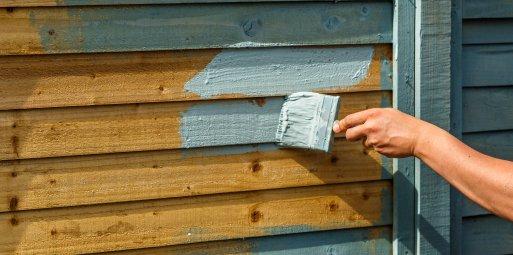Whether you’re putting up a new fence or looking to give one that is already in place a fresh look, it’s important to choose the right paint so that you don’t have to worry about redoing it for a long time. But choosing the right paint can be difficult, especially with the large selection of paints available on the market. Keep reading to learn more about the best paint for wood fence, the difference between painting and staining, and more.

Is It Better to Paint or Stain a Fence?
Read more : 7 Best Outdoor Dog Kennels: Keeping Your Canine Safe Outside!
One of the more common questions people may have when finishing a fence is whether it’s better to use a stain or traditional paint. There are a lot of different variables to consider, but the most important thing to keep in mind is that it’s essential to protect your wood with something to help it withstand weather and the test of time. Plain wood may look nice, but the elements and other environmental factors will cause damage to the wood, break it down, and cause mold.
Paint
- If you are considering using paint, the biggest advantage is the variety of colors and finishes. These days you can go to any hardware store and come out with paint in any color imaginable. Black fencing has become popular in recent years, but you could also paint your fence red, blue, white, turquoise, or any other color. Want to give your fencing an edgy look? You can even go for matte finishes instead of a more traditional glossy look. Paint is best for more absorbent woods because it sits on top of the surface and doesn?t need to soak in; in this instance, it would take less paint than stain to cover the entire surface. But regardless of the type of wood, you are going to need more than one coat of paint.
Stain
- Unlike paint, stain is thinner and will soak into the wood instead of sitting on top of it. Stain is also more forgiving than paint, which is a bonus if you are a novice looking to do it yourself without the help of a professional. Stain may not require a primer before you stain your fence and is a lot easier to get uniform color and coverage with. Stain is also best if the wood you’re painting is rough or highly-textured. If you do opt to use stain, you need to be sure that the weather will permit you to apply it properly. For the stain to go on smoothly and set correctly, the temperature needs to be at least 50 degrees, and it’s important to try to pick a week that is not predicted to have rain for at least two days in a row.

Do You Need to Prime a Fence Before Painting?
If you opt to paint your fence instead of staining it, it’s essential that you use a primer to extend the life of your fence. Primers fill in the wood’s pores and act as a surface for topcoats to stick to and help them offer higher coverage. Newly constructed fencing contains chemicals that bleed through paint’s finish and cause premature cracking, peeling, or blistering. A good, acrylic wood primer will work to seal those chemicals in and help keep the paint looking great for many years. Alkyd primers, or primers with an oil-base, are the traditional choice and will work just fine, but there are also more high-quality acrylic latex primer options available.
What Kind of Paint Do You Use on a Fence?
Read more : Indoor Mum Care: Growing Chrysanthemums Indoors
Not all paints are created equal. If you are considering painting your fence yourself, then you need to do your due diligence before deciding on a paint. Most professional painters recommend using an acrylic latex paint on a wooden fence because it provides a good moisture barrier that will not only protect your fence from rain, but also garden sprinklers and other sources of water. Latex paints are also more flexible than oil-based paint, which means it will be able to expand and contract with temperature changes and in direct sunlight.
What is the Fastest Way to Paint a Fence?
If you are dead-set on painting the fence by yourself, it’s going to take you awhile using just a bucket and paintbrush. A paint sprayer is the way to go if you are looking for a way to get the job done fast while maintaining even coverage. This device will help you cover more surface area than if you were just using a paintbrush or a roller. But we still believe that, unless you have the time and money to go back in and potentially remove the paint if something goes wrong, the most cost-effective thing to do is to hire a professional.
Let the Pros Paint Your Fence
At Pro Painters, we believe in the importance of a job done right the first time. Taking on a DIY painting job can be a lot of work. If you don’t have the time or energy to properly prepare and execute the job, odds are that it won’t be done to your liking. Let us take the pressure off of you! Contact us today for a free quote, to get information on the best paint for wood fence, or to learn more about our quality-assurance guarantee.
Source: https://gardencourte.com
Categories: Outdoor

